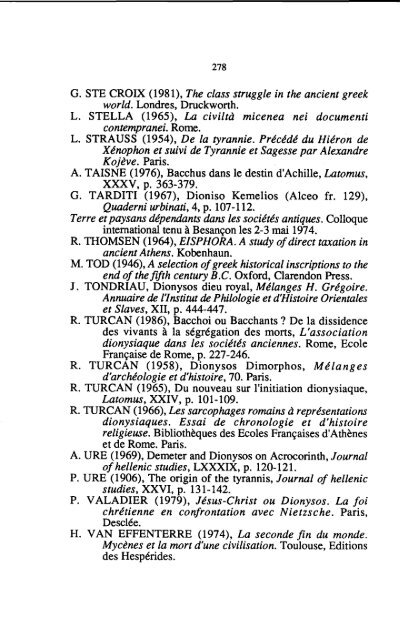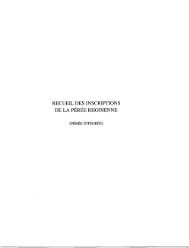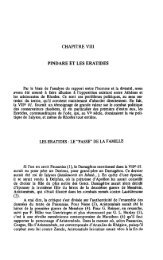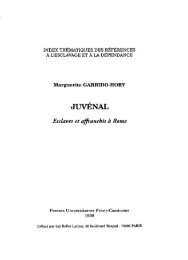Archaic and classical greek coins. - Institut des sciences et ...
Archaic and classical greek coins. - Institut des sciences et ...
Archaic and classical greek coins. - Institut des sciences et ...
You also want an ePaper? Increase the reach of your titles
YUMPU automatically turns print PDFs into web optimized ePapers that Google loves.
278<br />
G. STE CROIX (1981), The class struggle in the ancient <strong>greek</strong><br />
world. Londres, Druckworth.<br />
L. STELLA (1965), La civiltà micenea nei documenti<br />
contempranei. Rome.<br />
L. STRAUSS (1954), De la tyrannie. Précédé du Hiéron de<br />
Xénophon <strong>et</strong> suivi de Tyrannie <strong>et</strong> Sagesse par Alex<strong>and</strong>re<br />
Kojève. Paris.<br />
A. TAISNE (1976), Bacchus dans le <strong>des</strong>tin d'Achille, Latomus,<br />
XXXV, p. 363-379.<br />
G. TARDITI (1967), Dioniso Kemelios (Alceo fr. 129),<br />
Quaderni urbinati, 4, p. 107-112.<br />
Terre <strong>et</strong>paysans dépendants dans les sociétés antiques. Colloque<br />
international tenu à Besançon les 2-3 mai 1974.<br />
R. THOMSEN (1964), EISPHORA. A study ofdirect taxation in<br />
ancient Athens. Kobenhaun.<br />
M. TOD (1946), A selection of<strong>greek</strong> historical inscriptions to the<br />
end ofthefifth century B.e. Oxford, Clarendon Press.<br />
1. TONDRIAU, Dionysos dieu royal, Mélanges H. Grégoire.<br />
Annuaire de l'<strong>Institut</strong> de Philologie <strong>et</strong> d'Histoire Orientales<br />
<strong>et</strong> Slaves, XII, p. 444-447.<br />
R. TURCAN (1986), Bacchoi ou Bacchants? De la dissidence<br />
<strong>des</strong> vivants à la ségrégation <strong>des</strong> morts, L'association<br />
dionysiaque dans les sociétés anciennes. Rome, Ecole<br />
Française de Rome, p. 227-246.<br />
R. TURCAN (1958), Dionysos Dimorphos, Mélanges<br />
d'archéologie <strong>et</strong> d'histoire, 70. Paris.<br />
R. TURCAN (1965), Du nouveau sur l'initiation dionysiaque,<br />
Latomus, XXIV, p. 101-109.<br />
R. TURCAN (1966), Les sarcophages romains à représentations<br />
dionysiaques. Essai de chronologie <strong>et</strong> d'histoire<br />
religieuse. Bibliothèques <strong>des</strong> Ecoles Françaises d'Athènes<br />
<strong>et</strong> de Rome. Paris.<br />
A. URE (1969), Dem<strong>et</strong>er <strong>and</strong> Dionysos on Acrocorinth, Journal<br />
ofhellenic studies, LXXXIX, p. 120-121.<br />
P. URE (1906), The origin of the tyrannis, Journal of hellenic<br />
studies, XXVI, p. 131-142.<br />
P. VALADIER (1979), Jésus-Christ ou Dionysos. La foi<br />
chrétienne en confrontation avec Ni<strong>et</strong>zsche. Paris,<br />
Desclée.<br />
H. VAN EFFENTERRE (1974), La seconde fin du monde.<br />
Mycènes <strong>et</strong> la mort d'une civilisation. Toulouse, Editions<br />
<strong>des</strong> Hespéri<strong>des</strong>.





